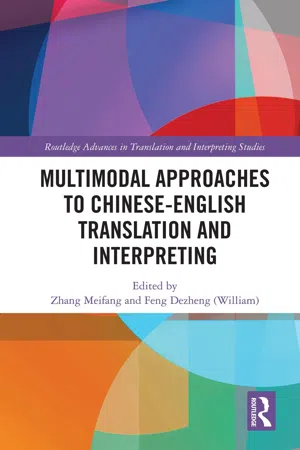
Multimodal Approaches to Chinese-English Translation and Interpreting
- 296 pages
- English
- ePUB (mobile friendly)
- Available on iOS & Android
Multimodal Approaches to Chinese-English Translation and Interpreting
About This Book
Nowadays, discourse analysis deals with not only texts but also paratexts and images; so do translation and interpreting studies. Therefore, the concept of multimodality has become an increasingly important topic in the subject areas of linguistics, discourse analysis and translation studies. However, up to now not much research has been done systematically on multimodal factors in translation and interpreting, and even less in exploring research models or methodologies for multimodal analysis in translation and interpreting.
This book aims to introduce and apply different theories of the multimodal discourse analysis to the study of translations, with case studies on Chinese classics such as the Monkey King, Mulan and The Art of War, as well as on interpretations of up-to-date issues including the Chinese Belt and Road Initiatives and Macao tourism.
The chapters reflect the first attempts to apply multimodal approaches to translation and interpreting with a special focus on Chinese-English translations and interpreting. They provide new understandings of transformations in the multimodal translation process and useful reference models for researchers who are interested in doing research of a similar kind, especially for those who are interested in looking into translations related to Chinese language, literature and culture.
Frequently asked questions
Information
1
Intersemiotic shifts in the translation of Chinese costume drama subtitles
1 Introduction
2 Multimodality: a networked system of choices
3 Analytical framework
| Semiotic shift | Description |
|---|---|
| | |
| Adiectio (Addition) | The translation of the source text involves the incorporation of additional signs, whether they are "new images, sounds, dialogue or spoken comments." |
| Detractio (Omission) | The translation results in a reduction of the verbal and non-verbal semiotics deployed in the source text. |
| Substitutio (Substitution) | Replacing one sign with a (more or less) equivalent one from a different code. It may involve a partial substitution of visual and nonverbal signs by verbal signs conveyed through the visual channel. |
Table of contents
- Cover
- Half Title
- Series Page
- Title Page
- Copyright Page
- Contents
- List of figures
- List of tables
- List of contributors
- Acknowledgements
- Introduction: multimodal approaches to Chinese-English translation and interpreting
- 1 Intersemiotic shifts in the translation of Chinese costume drama subtitles: a multimodal analysis approach
- 2 A multimodal study of paratexts in bilingual picturebooks on Mulan
- 3 Intersemiotic translation of rhetorical figures: a case study of the multimodal translation of The Art of War
- 4 Reshaping the heroic image of Monkey King via multimodality: a hero is back
- 5 “Dis”covering Hamlet in China: a case analysis of book covers of the Chinese Hamlet
- 6 Belt and Road Initiatives in texts and images: a critical perspective on intersemiotic translation of metaphors
- 7 A corpus-assisted multimodal approach to tourism promotional materials of Macao: a case study of three signature events
- 8 Effects of non-verbal paralanguage capturing on meaning transfer in consecutive interpreting
- Index